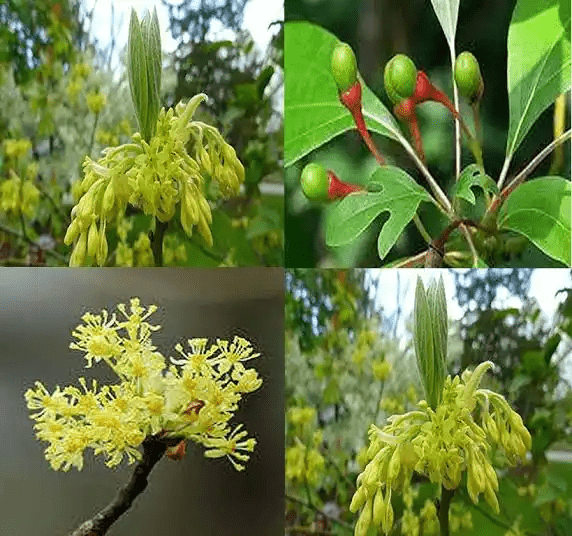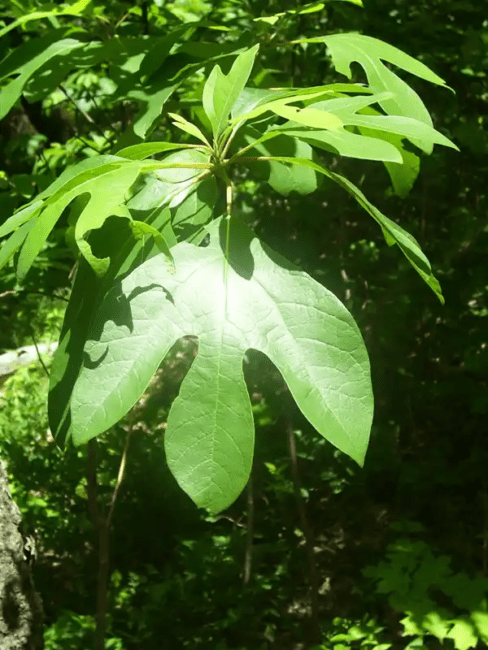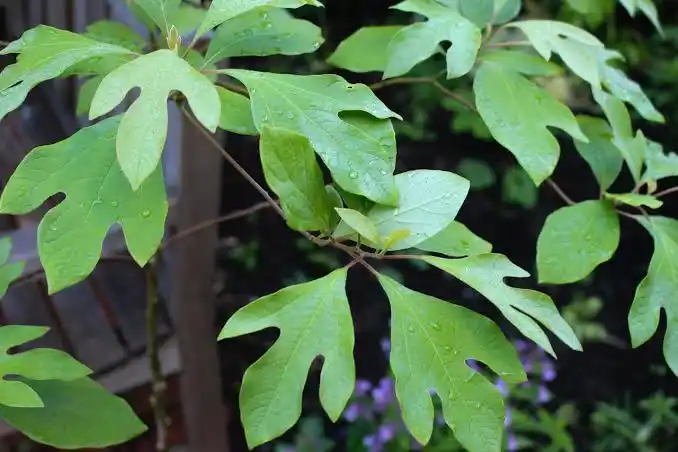Sassafras albidum, commonly known as Common Sassafras, is a deciduous tree native to eastern North America. This tree is renowned for its unique and distinctive features, making it a beloved addition to both natural landscapes and gardens.
The Common Sassafras typically reaches heights of 30 to 60 feet, with a broad, irregularly shaped crown. Its bark is dark brown, rough, and deeply furrowed, adding to its rustic charm.
The most remarkable aspect of this tree is its mitten-shaped leaves, which come in three different shapes: oval, three-lobed, and mitten-shaped. This variation in leaf shape within the same tree is quite unusual and adds to its allure.
During spring, Sassafras albidum produces small, yellow-green flowers that grow in clusters, followed by dark blue-black, spherical fruit that attract various wildlife.
Notably, its aromatic roots and leaves have been used for centuries in traditional medicine and culinary applications, lending a unique flavor to foods and beverages.
Common Sassafras is also known for its vibrant fall foliage, with leaves turning brilliant shades of orange, red, and purple, making it a sought-after ornamental tree.
It’s an essential part of the ecosystem, providing food and shelter for wildlife and adding aesthetic beauty to the landscapes it graces. Sassafras albidum is a symbol of the rich biodiversity and natural beauty of the eastern United States.
The Botanical Description of Sassafras albidum
1. Family and Genus: Sassafras albidum belongs to the family Lauraceae. The genus Sassafras includes several species, with Sassafras albidum being one of the most well-known.
2. Size and Growth: Sassafras is a medium-sized tree that typically reaches heights between 30 to 60 feet (9 to 18 meters). It has a slender trunk with an irregular, branching crown.
3. Leaves: The most distinctive feature of sassafras is its leaves. They are alternate, simple, and variable in shape. Leaves can be entire or exhibit three distinct shapes on the same tree: oval, mitten-shaped, and three-lobed. The three-lobed leaves resemble a mitten, which adds to the tree’s uniqueness.
4. Bark: The bark of sassafras is smooth and green when young, turning reddish-brown as the tree matures. It exudes a citrus-like scent when scratched or bruised.
5. Flowers: Sassafras trees are dioecious, meaning there are separate male and female trees. Small, inconspicuous flowers appear in early spring before the leaves emerge. Male flowers are yellowish-green clusters, while female flowers are solitary and pale green.
6. Fruit: The fruit of sassafras is a dark blue-black, elliptical drupe, about 1/3 inch long, borne on a bright red stalk. These drupes mature in late summer and are an important food source for wildlife.
7. Root System: Sassafras has a deep and extensive root system that helps anchor the tree.
8. Aromatic Roots: One of the most notable features of sassafras is its aromatic roots. They contain safrole, a compound responsible for the tree’s distinct scent. The roots have been used historically in the production of sassafras tea and for flavoring various dishes.
9. Fall Foliage: Sassafras is famous for its vibrant fall foliage. The leaves turn various shades of yellow, orange, and red, creating a striking autumn display.
The Geographic Distribution of Sassafras albidum
1. Native Range: Sassafras albidum is native to eastern North America. It is primarily found in the eastern and central United States, including states such as Alabama, Florida, Georgia, Kentucky, Louisiana, Mississippi, and more. Its range extends northward into southern Ontario, Canada.
2. Habitat: Sassafras is adaptable to various habitats and can be found in a range of forest types, from upland hardwood forests to wetland areas. It often thrives in well-drained soils but can tolerate a variety of soil types.
3. Ecological Importance: Sassafras plays a crucial role in its native ecosystems. The fruit and foliage provide food for numerous wildlife species, including birds, mammals, and insects. It is a pioneer species, often one of the first trees to colonize disturbed areas.
4. Historic and Cultural Significance: Sassafras has historical and cultural significance in the eastern United States. Indigenous peoples and early European settlers used it for various purposes, including medicinal remedies and flavoring.
The Chemical Composition of Sassafras albidum
1. Safrole: Safrole is a key chemical compound found in sassafras roots, leaves, and bark. It is responsible for the characteristic sweet and spicy aroma of sassafras. Safrole has been used historically in the production of sassafras tea and for flavoring.
2. Essential Oil: Sassafras essential oil is derived from the roots and leaves and contains safrole as a major component. The oil is known for its aromatic properties and has been used in perfumery and aromatherapy.
3. Tannins: Sassafras leaves contain tannins, which contribute to their astringency and have been used in traditional herbal remedies.
4. Beta-Caryophyllene: This sesquiterpene is found in the essential oil of sassafras and contributes to its aroma.
5. Myristicin: Myristicin is another compound present in sassafras and contributes to its flavor.
6. Nutrient Value: Sassafras leaves are a source of nutrients, including vitamin C, and have been used for brewing sassafras tea.
Read Also: Which Herbs and Spices are good for you (cinnamon, paprika, etc)
The Medicinal Health Benefits Of Sassafras albidum (Common Sassafras)

1. Blood Purification: Sassafras is believed to purify the blood, promoting overall health and well-being. It is traditionally used in herbal remedies to cleanse the bloodstream.
2. Arthritis Relief: The anti-inflammatory properties of sassafras may help alleviate symptoms of arthritis. It is used in various forms, such as teas and tinctures, to reduce joint pain and swelling.
3. Respiratory Health: Sassafras is used to treat respiratory issues like coughs and congestion. Its expectorant properties help clear the respiratory passages, making it easier to breathe.
4. Skin Disorders: Sassafras is traditionally used to treat skin conditions such as eczema and psoriasis. Its antibacterial properties can help soothe irritated skin and promote healing.
5. Digestive Aid: Sassafras tea is known to aid digestion. It helps in relieving indigestion, bloating, and gas, promoting a healthy digestive system.
6. Fever Reduction: Sassafras is used in folk medicine to reduce fevers. Its diaphoretic properties promote sweating, which can help lower body temperature during febrile conditions.
7. Liver Health: Sassafras is believed to support liver function. It is used in herbal remedies to detoxify the liver and improve its overall health.
8. Stress Reduction: Sassafras tea is known for its calming effects. It helps reduce stress and anxiety, promoting relaxation and mental well-being.
9. Menstrual Pain Relief: For centuries, sassafras has been used to alleviate menstrual cramps and discomfort. It is believed to have mild analgesic properties.
10. Antioxidant Properties: Sassafras contains antioxidants that help neutralize harmful free radicals in the body, contributing to overall health and longevity.
11. Immune Boost: The natural compounds in sassafras may help boost the immune system, enhancing the body’s ability to fight off infections and illnesses.
12. Dental Health: Sassafras is traditionally used for oral care. Its antimicrobial properties can help prevent oral infections and promote gum health.
13. Weight Management: Some herbal practitioners suggest that sassafras may aid in weight management by promoting a feeling of fullness and supporting the body’s metabolism.
14. Antispasmodic Properties: Sassafras is known for its antispasmodic effects, which can help relieve muscle cramps and spasms.
15. Anti-Cancer Potential: While research is ongoing, some studies suggest that certain compounds in sassafras may have anti-cancer properties, making it a subject of interest in cancer research.
16. Joint Health: Regular consumption of sassafras tea is believed to promote joint health, reducing the risk of joint-related issues in the long term.
The Methods of Usage to Achieve the Provided Health Benefits Of Sassafras albidum (Common Sassafras)
1. Sassafras Tea: Brewing sassafras leaves or root bark into tea is a common method of consumption. It is believed to provide many of the plant’s health benefits, including blood purification and digestive aid.
2. Tinctures: Sassafras tinctures, made by steeping the plant in alcohol, are used for various medicinal purposes. Tinctures offer a concentrated form of the plant’s beneficial compounds.
3. Topical Applications: Infused oils or salves made from sassafras are used topically to treat skin disorders. Applying these preparations to affected areas can help soothe irritation and promote healing.
4. Inhalation: Inhaling the steam from sassafras tea or essential oil-infused water can help with respiratory issues. The inhalation of sassafras vapors is believed to clear the airways and alleviate congestion.
5. Dietary Supplements: Sassafras supplements, available in capsule or powder form, are used to promote overall health. These supplements are often taken under the guidance of healthcare professionals.
6. Herbal Baths: Adding sassafras leaves or oils to a warm bath is believed to promote relaxation and soothe muscle tension. Herbal baths are often used for stress reduction and overall well-being.
The Side Effects Of Using Sassafras albidum Medicinal Plant
1. Liver Damage: Sassafras contains safrole, a compound that has been linked to liver damage and cancer in high doses. Long-term or excessive use of sassafras products may pose a risk to liver health.
2. Allergic Reactions: Some individuals may be allergic to sassafras. Allergic reactions can range from mild skin irritation to severe respiratory distress. It’s important to perform a patch test before using sassafras topically.
3. Safrole Content: Safrole, present in sassafras, is a potential carcinogen. The compound is banned as a food additive in the United States due to its carcinogenic properties. Using sassafras products with high safrole content should be avoided.
4. Pregnancy and Breastfeeding: Pregnant and breastfeeding individuals should avoid sassafras due to the potential risks associated with safrole. Safrole can pass through breast milk to infants.
5. Drug Interactions: Sassafras may interact with certain medications or medical conditions. It’s essential to consult a healthcare professional before using sassafras supplements, especially if taking prescribed medications.
6. Digestive Issues: In some cases, sassafras tea or supplements may cause digestive issues such as nausea, vomiting, or diarrhea. Individuals with sensitive stomachs should consume sassafras in moderation.
7. Blood Pressure: Sassafras may affect blood pressure. Individuals with hypertension or other heart-related conditions should avoid sassafras or consult a healthcare provider before use.
Please note that while sassafras has been traditionally used for various medicinal purposes, it’s essential to use it cautiously and under the guidance of qualified healthcare professionals due to its potential risks and side effects.
Read Also: 5 Medicinal Health Benefits Of Viola adunca (Hookspur Violet)
The Scientific Research and Studies of Sassafras albidum

Sassafras has been the subject of scientific research and studies to explore its potential health benefits and risks. Some key findings include:
1. Antioxidant Properties: Scientific studies have confirmed the antioxidant properties of sassafras, attributed to compounds like polyphenols. These antioxidants help combat oxidative stress and reduce the risk of chronic diseases.
2. Safrole and Carcinogenicity: Research has identified safrole, a natural compound in sassafras, as a potential carcinogen. Due to its carcinogenic properties, safrole is regulated and restricted in various countries, including the United States.
3. Antibacterial Effects: Studies have shown that sassafras possesses antibacterial properties. These properties can help inhibit the growth of harmful bacteria and contribute to oral health.
4. Potential Anti-Inflammatory Effects: Some research suggests that sassafras may have anti-inflammatory effects. These effects can be beneficial for conditions involving inflammation, such as arthritis.
5. Liver Health: Scientific investigations have highlighted the potential risks to the liver associated with sassafras consumption, especially due to its safrole content. Excessive or prolonged use of sassafras products may lead to liver damage.
6. Traditional Use and Folk Medicine: Studies often explore the traditional uses of sassafras in various cultures. These investigations help understand its historical significance and the basis for its traditional medicinal applications.
7. Herbal Remedies and Ethnobotany: Ethnobotanical research delves into the traditional knowledge and practices related to sassafras. This includes its use in herbal remedies and cultural significance.
8. Toxicology and Safety: Research on sassafras includes toxicological assessments to determine its safety profile. This research is crucial in establishing safe usage guidelines.
9. Bioactive Compounds: Scientists have identified and studied the bioactive compounds present in sassafras, shedding light on its potential medicinal properties.
10. Legal and Regulatory Aspects: Studies may address the legal and regulatory aspects of sassafras, particularly in regions where safrole is restricted or banned.
The Safety Precautions and Recommendations In Using Sassafras albidum Medicinal Plant
While sassafras has traditional uses and potential health benefits, it is essential to take safety precautions and follow recommendations when using sassafras medicinally:
1. Safrole Content: Be aware of the safrole content in sassafras. Safrole is a potential carcinogen and is regulated in various countries. Avoid products with high safrole levels.
2. Consult a Healthcare Professional: Before using sassafras medicinally, consult a qualified healthcare professional, especially if you are pregnant, nursing, have liver conditions, or are taking medications.
3. Limit Consumption: Consume sassafras in moderation. Excessive or prolonged use may pose health risks, particularly to the liver.
4. Allergy Testing: Perform a patch test before applying sassafras topically to check for any allergic reactions. Discontinue use if irritation occurs.
5. Legal Considerations: Understand the legal regulations regarding sassafras in your region. Safrole restrictions vary, and it’s important to comply with relevant laws.
6. Alternative Options: Consider alternative herbal remedies with similar benefits and fewer safety concerns. Always explore safer alternatives when available.
7. Avoid High-Risk Groups: Do not administer sassafras to children, infants, or individuals at higher risk of safrole-related health issues.
FAQs About Sassafras albidum Medicinal Plant
1. Is sassafras safe to use for its health benefits?
Sassafras should be used with caution. Its safrole content may pose health risks. Consult a healthcare professional before using it medicinally.
2. Are there safer alternatives to sassafras for its health benefits?
Yes, there are safer herbal remedies with similar benefits. Consider alternatives, especially if you are concerned about safrole.
3. Can sassafras be used for culinary purposes?
Sassafras leaves have been traditionally used to flavor foods. However, the use of safrole-rich sassafras oil as a flavoring agent is restricted in some regions.
4. What are the potential side effects of sassafras consumption?
Potential side effects may include liver damage, allergic reactions, digestive issues, and interactions with medications. Exercise caution.
5. Can sassafras be used topically for skin conditions?
Sassafras can be used topically, but a patch test is recommended to check for allergic reactions. Discontinue use if irritation occurs.
6. Is sassafras legal in my region?
Legal regulations regarding sassafras, especially safrole content, vary by region. Check your local laws and regulations.
7. What traditional uses of sassafras are still practiced today?
Traditional uses of sassafras, such as in herbal teas, may still be practiced. However, safety precautions are essential.
8. Are there ongoing scientific studies on sassafras?
Yes, ongoing research explores the properties and safety aspects of sassafras, including its bioactive compounds and potential health risks.
9. Can sassafras be used as an essential oil?
Sassafras essential oil is available, but it should be used cautiously due to its safrole content. Consult a healthcare professional before using it.
10. What are the known benefits of sassafras?
Sassafras is traditionally used for blood purification, skin health, and as a digestive aid. It also has potential antioxidant and anti-inflammatory properties.
11. Can sassafras interact with medications?
Sassafras may interact with certain medications. If you are taking prescription drugs, consult a healthcare professional before using sassafras.
12. Is sassafras suitable for individuals with liver conditions?
Individuals with liver conditions should avoid sassafras due to its potential risks to liver health.
13. How can I ensure the sassafras I use is safe?
To ensure safety, buy sassafras products from reputable sources, check safrole content, and follow safety guidelines.
14. Can sassafras be used for children?
Sassafras is not recommended for children due to the potential risks associated with safrole.
15. Are there any cultural or historical uses of sassafras worth exploring?
Sassafras has a rich cultural and historical significance in traditional medicine and indigenous practices. Exploring its historical uses can provide valuable insights.
16. What precautions should be taken when using sassafras topically for skin conditions?
Perform a patch test to check for allergic reactions before applying sassafras topically. Discontinue use if irritation occurs.
These FAQs provide essential information about sassafras, its safety, and potential health benefits, while emphasizing the importance of responsible usage.
Read Also: Exploring the Benefits of Republic Garbage Service

